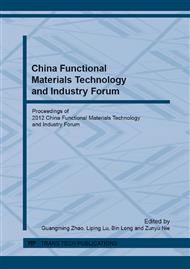p.255
p.259
p.265
p.270
p.275
p.281
p.287
p.296
p.303
The Preparation of Nanosized Iron Oxide Using Hydrolysis Enhanced by CuO and their Characterization
Abstract:
By adding CuO into heated Fe (NO3)3 aqueous solution, a precipitation reaction takes place to form nanosized iron oxide. The product obtained were characterized by transmission electron microscopy (TEM), vibrating sample magnetized (VSM), X-ray diffraction (XRD), energy disperse X-ray spectroscopy (EDX) and X-ray photoelectron spectroscopy (XPS). The experimental results showed that the product is weakly magnetic nanoclusters based on smaller ferrihydrite Fe5O7(OH)·4H2O nanocrystallites. The nanoclusters are of about 40 nm size and absorbed by Fe (NO3)3. The experimental results are attributed to the Fe (NO3)3 hydrolysis reaction being enhanced by CuO as hydrolyte. A new route is proposed for the preparation of nanosized oxide using hydrolysis enhanced.
Info:
Periodical:
Pages:
275-280
Citation:
Online since:
May 2013
Authors:
Keywords:
Price:
Сopyright:
© 2013 Trans Tech Publications Ltd. All Rights Reserved
Share:
Citation:


